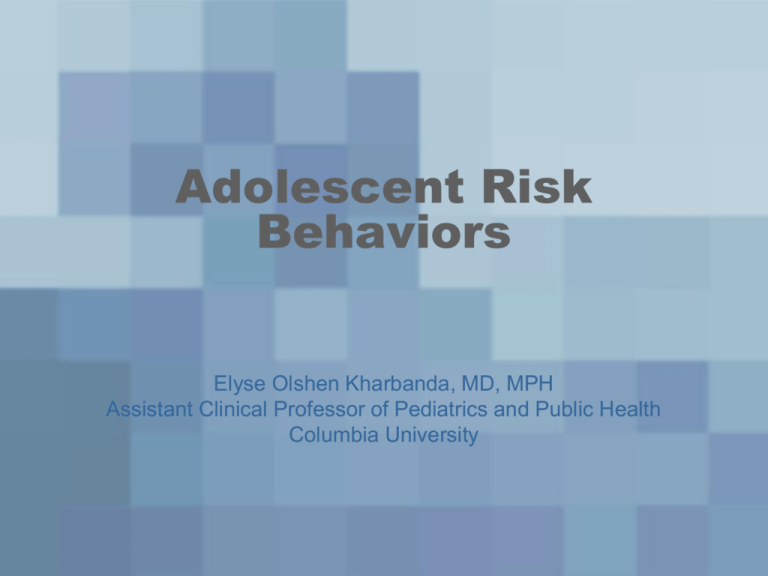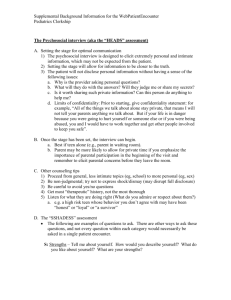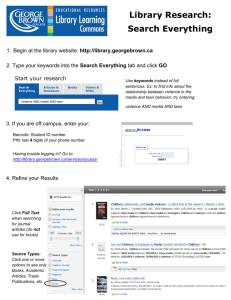Adolescent Risk Behaviors
advertisement

Adolescent Risk Behaviors Elyse Olshen Kharbanda, MD, MPH Assistant Clinical Professor of Pediatrics and Public Health Columbia University Adolescent risk behaviors Why adolescents take risks • Developing one’s own moral code and establishing an identity, separate from parents is a major task of adolescence – Early adolescence (ages 11-14) – first stages of separation from parents, desire to look and act like peers, difficulty with impulse control – Middle adolescence (ages 15-17) – further distancing from parents and allying with peers, feelings of omnipotence and immortality can lead to dangerous behaviors – Late adolescence (ages 18-21) - fully identify one’s own moral code, more confident and better able to delay gratification, can be protective factors Why do we care? • Testing limits is part of normal adolescent emotional and psychological development • Adolescent risk behaviors can lead to significant morbidity and mortality • Risk behaviors are often interrelated • Adolescents who participate in multiple risky behaviors are often depressed or have other mental illness Mortality statistics • Adults 1. Heart disease 2. Cancer 3. Stroke • Adolescents 1. Accidents 2. Homicide 3. Suicide Morbidity statistics • Nearly 1 million US teens become pregnant every year • Nearly 4 million teens contract a STI each year • Alcohol consumption is associated with motor vehicle injuries and fatalities, unwanted sexual activity, unprotected sexual activity, violence perpetration and violence victimization Plan for presentation • Unintentional Injuries • Violence • Suicide • Smoking/drinking/ drugs • Cutting • Teen Pregnancy • Obesity • Epidemiology (National and NYC data) • Implications • How to screen/counsel patients related to these issues Definition of injury • Unintentional or intentional damage to the body resulting from acute exposure to thermal, mechanical, electrical, or chemical energy or from the absence of such essentials as heat or oxygen Unintentional injuries – National data • Leading cause of mortality among adolescents 10-19 years • Approximately 8000 deaths due to unintentional injury in 2005 • 71% mortality due to MVAs • Approximately 2/3 of MVA related mortality is alcohol-related More about injuries • Injuries are not accidents. They can be prevented by changing the environment, individual behavior, products, social norms, legislation, and governmental and institutional policy Accidents/Unintentional injuries • Data from NYC YRBS – % students reported they never or rarely wore a seat belt 16% – % students who in past 30 days rode in car with driver who had been drinking 18% – % students who in past 30 days drove a car after drinking 4% – % students who rode a bicycle reported they never or rarely wore a helmet 90% Accidents/Unintentional injuries • Screening regarding safety at medical visits • Seat belts • Bicycle helmets • Drinking and driving Violence • “Threatened or actual use of physical force or power against another person, against oneself, or against a group or community that either results in or has a high likelihood of resulting in injury, death, or deprivation” Violence – National data • Homicide is the second leading cause of death in adolescents • 2000 deaths annually among 15-19 year olds • Homicide rates (ages 15-19) by race – White males 3.6 per 100,000 – Hispanic males 26.6 per 100,000 – Black males 60.6 per 100,000 Violence – National data • Approximately 9% of US high school students report lifetime history of sexual assault • Up to 40% of adolescents report history of dating violence • Victimization associated with future victimization, depressive symptomatology, increased risk behaviors and future suicide attempts Violence – NYC data • From 2005 NYC YRBS – % students who carried a weapon at least once in past 30 days 17% – % students who did not go to school at least once in past 30 days because they felt unsafe 9% – % students in past year who were in a physical fight 36% Violence • Screening – – – – – access to firearms carrying a weapon fighting with peers gang membership dating violence/sexual assault • Intervention – For youth with violence related behaviors, evaluate readiness to change – Evaluate youth with histories of aggression for psychiatric comorbidity – consider psych referral Suicide – National data • Third leading cause of death among adolescents • Approximately 1600 suicides per year among 10-19 year olds • Suicide rates by gender (ages 14-19) – – – – – – Females 2.5 per 100,000 10.3 per 100,000 Males Suicide rates by race (ages 14-19) Whites 7.4 per 100,000 Hispanic 5.4 per 100,000 3.5 per 100,000 Blacks Suicide – NYC data • 2005 NYC YRBS – % students who felt sad or hopeless daily for 2 weeks in past 12 months 32% – % students who seriously considered attempting suicide in the past 12 months 15% – % students who attempted suicide in the past 12 months 10% Suicide – risk factors • • • • Prior suicide attempts Depression Alcohol or substance abuse Associated with multiple other risky behaviors – – – – Smoking Early sexual activity Violence victimization Disordered eating Suicide • Screening – Depression • Mood, affect, sleep, appetite, boredom, restlessness, social isolation, school/work performance – Impulsiveness – Mania – Suicidal ideation/suicide attempts • Interventions – Mental health referral – if actively suicidal, refer to C-CPEP – Involve parents/legal guardian SSRIs and suicidality • SSRIs are an effective treatment for depression (TADS) • Increasing SSRI use in 1990s associated decreased rates of suicide • Concern regarding reports of suicides following starting on SSRIS • Meta-analysis of published and unpublished data found increased suicidal thoughts/behaviors (no completed suicides in trials) • 2004 FDA Black Box warning on SSRIs for depressed children and adolescents Smoking/drinking/drugs - NYC data • NYC 2005 YRBS – % students who smoked in past 30 days (was 24% in 1999) 11% – % students who drank in past 30 days 36% – % students who reported binge drinking in past 30 days 14% – % students who used marijuana in past 30 days 12% – % students who sniffed glue, inhaled paints/aerosols, etc… 9% – % students offered, sold or given an illegal drug on school property in past year 26% Smoking/drinking/drugs • While many consider this to be a rite of passage, these behaviors are associated with significant morbidity and mortality • 2/3 MVA mortality is alcohol-related • Early smoking risk for use of other drugs • Drinking and drugs associated with – – – – – – unwanted sexual activity unprotected sexual activity violence perpetration and victimization problems with the law school failure Psychiatric co-morbidity Smoking/drinking/drugs • Interventions – CRAFFT screening tool 1. Have you ever ridden in a Car driven by someone (including yourself) who was high or had been using alcohol or drugs? 2. Do you ever use alcohol or drugs to Relax, feel better about yourself, or fit in? 3. Do you ever use alcohol or drugs while you are by yourself Alone? 4. Do you ever Forget things you did while using alcohol or drugs? 5. Do your Family or Friends ever tell you that you should cut down on your drinking or drug use? 6. Have you ever gotten into Trouble while you were using alcohol or drugs? – Scoring: 2 or more positive items indicate the need for further assessment. –From: Knight JR; Sherritt L; Shrier LA//Harris SK//Chang G. Validity of the CRAFFT substance abuse screening test among adolescent clinic patients. Archives of Pediatrics & Adolescent 156(6) 607-614, 2002. Cutting • Form of intentional self-injury without the intent of suicide • May involve any sharp objects – razors, glass, pins, etc… • Most common sites are arms, wrists, ankles • Most common among adolescent girls (up to 14% in one survey) Why do adolescents cut? • Means to cope with painful emotion • Relief of agitation or anxiety • Addictive quality – may result in release of endorphins • May be “contagious” • Associated with other psychopathology Cutting • Screening – Ask about self injury – Look for scars • Intervention – Refer to ER if injured or thought to be suicide attempt – Refer for mental health services • • • • Individual therapy Group therapy Family therapy Medications Sexual risk behaviors – National data • Approximately half of high school students are sexually active • Adolescents have the highest rates of STDs of all age groups • Young adults represent half of all new HIV cases in the US • Risky sexual practices can be sign of mental health issues or prior trauma history Sexual risk behaviors – NYC data • 2005 NYC YRBS – % students who ever had sexual intercourse 48% – % students with lifetime history of 4 or more partners 18% – % sexually active students who used a condom with last intercourse 69% Sexual risk behaviors • Screening – Need to talk to teens alone – teens of any age can access reproductive health care without parents – Sexual activity – Condom use – Partners – Prior STIs, pregnancy • Intervention – – – – Annual GC/CT testing Pap HIV, RPR HPV vaccine Teen pregnancy • While teen pregnancy rates were on a 10-year decline, they have increased in the past two years • Wide state-level variation exists Teen Pregnancy’s Link to Poverty and Other Social Issues • What are the chances of a child growing up in poverty if his/her mother: (1) gave birth as a teen, (2) was unmarried when the child was born, and (3) did not receive a high school diploma or GED? – 27% if one of these things happen. – 42% if two of these things happen. – 64% if three of these things happen. • If none of these things happen, a child’s chance of growing up in poverty is 7%. • A child born to a teen mother who has not finished high school and is not married is nine times more likely to be poor than a child born to an adult who has finished high It Matters, National Campaign schoolSource: and is Why married. Consequences of Teen Pregnancy • Only 40% of young teen mothers graduate from high school. • Teen fathers earn less than older fathers (20-21). • Compared to children born to older mothers (20-21 years old), children born to teen moms are more likely to: – – – – – to drop out of high school. to use Medicaid and SCHIP. to experience abuse/neglect. to enter the foster care system. to end up in prison (sons). The Costs of Teen Childbearing An Overview By The Numbers: The Public Costs of Teen Childbearing • Project goal: Measure the costs that could be averted if teen mothers, 19 and younger, delay their first birth to 20-21 years old. – What is the impact on the young mother and her child’s subsequent life outcomes and what does this cost taxpayers? • Both national and state-specific cost estimates have been measured. Costs Included in the Analysis • Costs linked to teen moms – Public assistance – Lost tax revenue • Costs linked to the children of teen parents – – – – Lost tax revenue Public Health Care Incarceration of sons Child welfare • Costs linked to teen fathers – Lost tax revenue National Findings • Teen childbearing costs taxpayers at least $9.1 billion annually. – Total cost breakdown is $8.6 billion for 17 and younger and $0.5 billion for 18-19 year olds. • Average annual public sector cost associated with a child born to a mother aged 17 and younger is $4,080. National Findings • Most of the costs of teen childbearing are associated with negative consequences for the children of teen mothers and include: – $1.9 billion for increased public sector health care costs – $2.3 billion for increased child welfare costs – $2.1 billion for increased costs for state prison systems (among adult sons of teen mothers) – $2.9 billion in lost tax revenue due to lower taxes paid by the children of teen mothers over their own adult lifetimes. Costs for the Children of Teen Mothers Children of teen mothers are more likely to: Have decreased educational attainment Earn less money Suffer high rates of child abuse and neglect Grow up poor Live in single-parent households Enter the child-welfare system Become teen mothers themselves Youth Development • Not all teens are behaving badly • Programs to address single risk behavior not successful • Helping teens attain a sense of competency, usefulness, empowerment, and resilience • Protective factors: family connectedness, spirituality, school connectedness, positive self-identity, self-efficacy Transtheoretical model • Developed by DiClemente and Prochaska • Integrates current behavior, intention to change, decisional balance, and strategies • Behavior is an incremental, continuous, and dynamic process • New behavior results from decision making processes that occur through series of stages • Each stage of change contains specific tasks Stages of change • • • • • • • Precontemplation Contemplation Preparation Action Maintenance Termination Relapse Precontemplation • Stage in which there is no intention to change in the foreseeable future (aprox 6 months) • May be uninformed or underinformed about consequences • May have tried to change and become demoralized Contemplation • Intend to change in the next 6 months • Are aware of the pros and cons • Profound ambivalence may keep someone stuck here for a long time Preparation • Self awareness of need to change and intent to do so within a month • May have taken some significant action in past year such as a class or seeing a health or mental health provider • Possible results of change considered • Empowerment, recognizing possible substitutes, and how to reward self • “How could we make a plan?” Clinician provides helping relationship Action • Has made overt changes in lifestyle in the last 6 months • For this stage must attain the criteria that professionals agree reduces risk i.e. with smoking total abstinence is required Maintenance • Estimate that this stage lasts from 6 months to 5 years • Are not working as hard to prevent relapse as in action stage. • Less temptation and more confidence Relapse • Treat as re-entry into another cycle • Recognize that stages from precontemplation or contemplation need to be relived Termination • Applies to some behaviors • No temptation and 100% self – efficacy • It is as if one never acquired the habit/risk in the first place.



